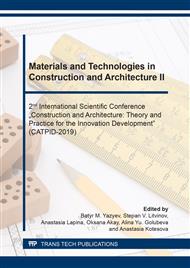p.482
p.491
p.496
p.505
p.510
p.515
p.521
p.529
p.535
Analysis of the Stress-Strain State of Ceramic Brick when Tested for Compressive Strength
Abstract:
The article analyzes the change in the stress-strain state of ceramic brick samples when tested in compression, depending on the variable parameters - the type of sample and the method of surface preparation. The experiment showed that the friction forces arising in the “sample-plate test press” zone of contact have a significant effect on the deformation conditions of the samples and lead to an uneven distribution of the breaking load over the surface. This in turn leads to an overestimation of the strength characteristics of the lot, and, consequently, to errors in the calculations of the bearing capacity of the structures. A numerical analysis of the stress distribution also showed that for the samples aligned by grinding and with the help of a mortar; the effect of compression caused by friction forces can be traced. Thus, the results of the numerical experiment are in good agreement with the results of the full-scale experiment. To increase the reliability of the test results, it is necessary to reduce the influence of friction forces and provide conditions for the realization of uniaxial compression. In this regard, it is necessary to adjust the standard test method, namely to use the technical felt gaskets as a method of preparing the surface.
Info:
Periodical:
Pages:
510-514
Citation:
Online since:
December 2019
Price:
Сopyright:
© 2020 Trans Tech Publications Ltd. All Rights Reserved
Share:
Citation:


